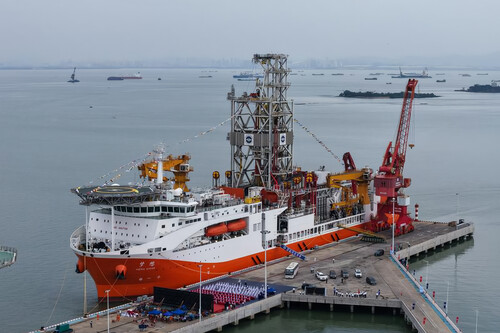Jules Verne’s aspiration in Journey to the Center of the Earth remains out of reach. Still, explorations beneath the seabed are pushing toward greater depths. A ship that China recently commissioned offers a clear example.
Meng Xiang. “Dream” in Chinese. This colossal ocean drilling vessel, designed and built entirely in China, can drill the ocean floor to a record depth of 6.8 miles.
The goal: penetrate the Earth’s crust and reach the mantle—a geological frontier scientists have only studied indirectly—and uncover new science while exploring potential energy sources.
It’s a mighty ship. At 550 feet long and weighing 42,600 tons, the Meng Xiang is China’s largest scientific research vessel, reinforcing the country’s status as a maritime superpower.
Although the vessel will focus on the South China Sea until 2035, it can operate in any ocean, withstanding super typhoons and extreme sea conditions.
What makes it unique? Its drilling system is the real jewel in the crown. The Meng Xiang features the world’s first hydraulic drilling tower capable of lifting 907 tons. It serves two purposes: conducting oil and gas exploration drilling and collecting geological core samples for scientific research.
Its 6.8-mile drilling capability will allow scientists to obtain direct samples from the transition zone for the first time. This ambition echoes the historic Mohole Project in the U.S. in the 1960s. That project laid the foundation for ocean drilling but never achieved its ultimate goal. China’s new vessel has the technology to succeed where the Mohole Project fell short.
The unexplored frontier. Since Croatian seismologist Andrija Mohorovičić discovered it in 1909, the Moho discontinuity has ranked among geology’s most coveted frontiers. It marks the boundary where the Earth’s lighter crust gives way to the much denser mantle rocks.
So far, scientists have studied this crucial layer through seismic data and by analyzing minerals ejected by volcanoes. China now aims to kill two birds with one stone by launching an unprecedented scientific mission that also expands its extraction capacity.
What might be found down there? In addition to oil, gas hydrates lie trapped in the seabed at great depths and low temperatures—a vast source of potential energy. Mastering their extraction could reshape the global energy landscape, and China intends to lead the way.
Image | Xinhua




View 0 comments